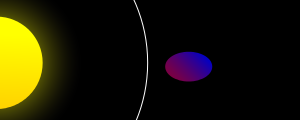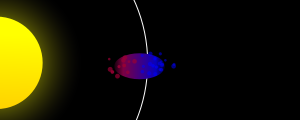
Back Rochelimiet Afrikaans Buega de Roche AN حد روش Arabic Мяжа Роша Byelorussian Граница на Рош Bulgarian Rocheova granica BS Límit de Roche Catalan Rocheova mez Czech Roche-Grenze German Όριο του Ρος Greek
 |
 |
 |
 |
 |
The Roche limit (pronounced /ˈroʊʃ/), or Roche radius, is a planetary distance.
Inside the Roche limit, orbiting material will form planetary rings. Outside the limit, material sticks together and forms satellites.[1]
The term is named after Édouard Roche, the French astronomer who first stated it in 1848.[2]
- ↑ Eric W. Weisstein (2007). "Eric Weisstein's World of Physics - Roche Limit". scienceworld.wolfram.com. Retrieved September 5, 2007.
- ↑ NASA. "What is the Roche limit?". NASA - JPL. Archived from the original on 2013-02-04. Retrieved September 5, 2007.